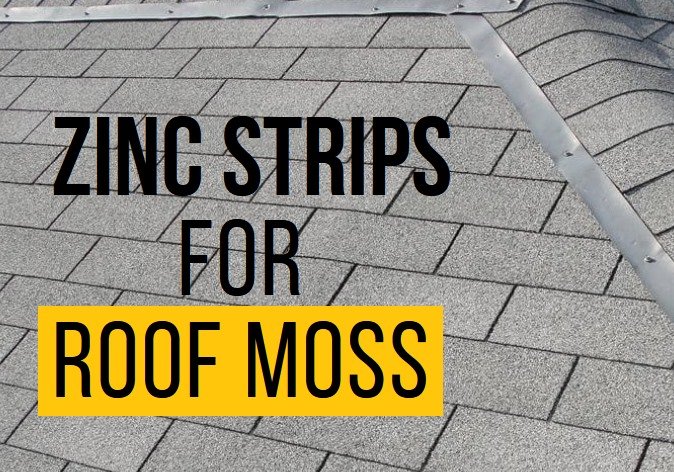Zinc strips can effectively moderate the growth of moss on roofs. During roof cleaning or when rainwater contacts zinc strips for roof moss, the zinc slowly releases into the air, creating a protective barrier against moss growth.
When the rainwater drains off, it prevents moss formation and other organic roofing materials on your roof.
Studies have revealed that zinc strips are only marginally beneficial, and their impact lasts only a short time. Many roofs need numerous layers for effective control because various studies indicate that zinc strips are effective for 5 to 15 feet below the zinc strip. Multiple layers of zinc strips are unattractive to the ordinary homeowner, making them unsuitable for moss management.

Additionally, research has revealed that zinc strips lose their potency after just five years. Therefore, it indicates that zinc strips are a temporary fix for roof moss and must be maintained.
Zinc Strips for Roof Moss
To eliminate lichen and moss growing there, you may either purchase these readymade strips from Shingle Shield or cut strips of zinc flashing (copper and lead also work) and slip them under a course of roof tiles. The readymade ones are significantly faster and undoubtedly appear cleaner.
It’s not a terrible idea to tell clients that the tree branches hanging over their roofs originally kept them moist and allowed the vegetation to thrive. The roof and the rest of the structure will dry up more rapidly if the trees in the area are pruned.
How to Install Zinc Strips for Roof
Many years ago, people used zinc strips to prevent roof moss from growing. Here is a description of their operation and installation. As well as dependable roofing methods and expertise, zinc strips have limitations.
Zinc strips function optimally when rain splashes onto the metal, which then releases zinc particles. This process helps in the gradual cleaning of the roof by preventing moss accumulation.
Algae, moss, lichen, fungus, mold, and other everyday plant life are all harmful to the metal and will damage your roof’s appearance and health.
When everything is functioning correctly, the developing moss will eventually wither, die, and come off, just like stains and other essential plant life creatures should. But, for around five years, it should help keep the moss at bay.
You must first put the zinc strips to prevent moss on the roof beneath every ridge cap, whether straight or angular, so rainwater can pass over them and equally treat the roof with leaching metal (hip).
The second layer of zinc strip needs to be laid 15 feet lower down the roof because the method only works for about 15 feet. Complete independence from moss for five years should occur if there is enough zinc for the rains to run over, in the proper locations, and if they are all level and even on the roof.
Don’t Zinc Strip
The use of zinc strips eradicates moss. If the zinc strip remains in place and is kept level for around five years, the moss and algae die, and the roof remains moss-free for a distance of 10 feet. Zinc strips are popular because they are well-marketed and frequently suggested.
- It Is Unsound to Install Zinc Strips on a Roof
Adding zinc after the roofing will make the nails visible. Although this goes against proper roofing practices, it works for a while because the nail head dings the soft metal.
The fact that expansion and contraction, a crucial factor in all roofing, work the nails out always prevails in exposed nail head circumstances. As a result of the nail hole becoming increasingly slack around the nail, rainfall will eventually leak in. That is erosion, which signals the beginning of a roof’s viability.
- Zinc Strips Lose Effectiveness When Oxidized
The exposed zinc develops a new chemical composition as light rust starts to appear. As a result, the zinc strips will become less efficient the more extended the rust remains.
- There Are Warps in the Zinc, Resulting in Uneven Roof Treatment
Several years after installation, zinc cups were sporadic. We see the water isn’t flowing across the strip equally despite all the installation work. The zinc particles are well-covered just beneath the least cupped places once it rolls down the strip in search of such areas.
Water rushes along the strip to locate the lowest places, which causes the warps and curls to create an uneven flow. As a result, it has a splotchy covering. The uneven flow of metal-saturated water produces inconsistent effectiveness, which is quite apparent.
- The Soft Metal Cracks and Breaks
The thin zinc strips deteriorate and crack in unexpected locations after five years. The material flops around the roof, making a mess of things and occasionally hitting the roofing surface and doing little harm.
- A Lot of 50 Foot Rolls of Zinc Strip Are Needed
All angular caps must have zinc strips put beneath them properly. Every 10 to 12 feet, a new horizontal line should be running down each field of the roof. You can see the zebra effect.
This provides a roof in the diagram. It’s not appealing to the eye since the stripes reflect sunlight. However, as you can see from the other arguments we’re making here, it’s not only an eyesore.
Bottom Line
For years, zinc strips for roof have been used to prevent moss growth on roofs. Zinc is gradually discharged into the air when rainfall comes into contact with zinc strips. The rain draining off your roof stops moss growth and other organic things.
Zinc strips are well-marketed and regularly recommended, which contributes to their popularity. However, installing zinc strips on a roof is a bad idea.


